Modeling and Experimental Study on Motion States of Laboratory-Scale Bottom Hole Assembly in Horizontal Wells
Abstract
1. Introduction
2. Dynamic Model
2.1. Basic Assumptions
- (1)
- The inner wall of wellbore is regarded as a continuous and uniform circular cross section;
- (2)
- The BHA is regarded as an elastic beam with homogeneous geometric characteristics and material properties and its deformation is within the linear elastic range;
- (3)
- Neglect the effect of bit-rock interaction, and the drill bit is used to bear the WOB and steady the BHA at the center part of the wellbore.
2.2. Dynamic Equations
2.3. Contact Model
3. Indoor Experiment
3.1. Experimental Setup
3.2. Similarity Criterion
3.3. Parameter Selection
4. Result and Discussion
4.1. Effects of Measuring Position
4.2. Effects of Rotate Speed
4.3. Effects of WOB
4.4. Effects of Friction Coefficient
5. Conclusions
- (1)
- The experimental results can match well with the numerical simulation results and it can prove that the BHA dynamic model is reasonable for analysing the motion states of BHA in horizontal wells.
- (2)
- The motion states of BHA in horizontal wells can be divided into three kinds, including circular arc swing, “8” shape swing, and dot-like circular motion. The circular arc swing mainly appears at the middle section of BHA and occurs through the collective result of gravity and friction. The dot-like circular motion mainly appears at the near-bit or near-stabilizer area because bit and stabilizer can steady the BHA at the center part of the wellbore. The “8” shape swing mainly appears at the crossed area and occurs through collective disturbance of the other two motions.
- (3)
- The rotate speed and friction coefficient have promotions on the lateral vibration, while WOB have a much smaller effect compared with the other two parameters. From the drilling engineering standpoint, a lower rotate speed is recommended as long as rotate speed can meet the requirement of ROP and thus it can protect downhole tools from fatigue failure or damage. A slightly large WOB is recommended in order to improve the ROP. Moreover, the rock stratum with a larger friction coefficient can make lateral vibration more violent and the drilling construction needs more attention.
- (4)
- The main purpose of the paper is to verify the full-dimensional continuous model. Thus, all the results are based on the small-scale model, instead of field-scale prototype. It is important to verify the given model and then the field-scale researches will be carried out in further study with the verified model. The effects of stabilizer will be studied in further study.
Author Contributions
Funding
Conflicts of Interest
References
- Huang, G.L.; Li, W.; Ni, H.J.; Meng, X.W.; Yu, F.; Wang, S.C. Mechanism analysis of pull-up and quick release technique during casing running process. J. China Univ. Pet. (Ed. Nat. Sci.) 2017, 41, 85–90. [Google Scholar]
- Li, W.; Liu, W.C.; Zhou, X.H.; Ni, H.J.; Yu, F.; Zang, Y.B. Three dimensional horizontal wellbore trajectory optimization design method in Fuling shale gas field. Pet. Drill. Tech. 2018, 46, 17–23. [Google Scholar]
- Chen, P.J.; Gao, D.L.; Shi, Y.C.; Wang, Z.H.; Huang, W.J. Study on aggressively working casing string in extended-reach well. J. Pet. Sci. Eng. 2017, 157, 604–616. [Google Scholar] [CrossRef]
- Albdiry, M.T.; Almensory, M.F. Failure analysis of drillstring in petroleum industry: A review. Eng. Fail. Anal. 2016, 65, 74–85. [Google Scholar] [CrossRef]
- Li, W.; Huang, G.L.; Jing, Y.H.; Yu, F.; Ni, H.J. Modeling and mechanism analyzing of casing running with pick-up and release technique. J. Pet. Sci. Eng. 2019, 172, 538–546. [Google Scholar] [CrossRef]
- Tian, J.L.; Yang, Y.L.; Yang, L. Vibration characteristics analysis and experimental study of horizontal drill string with wellbore random friction force. Arch. Appl. Mech. 2017, 87, 1439–1451. [Google Scholar] [CrossRef]
- Zhu, W.P.; Di, Q.F. Effect of prebent deflection on lateral vibration of stabilized drill collars. SPE J. 2011, 16, 200–216. [Google Scholar] [CrossRef]
- Zhu, X.H.; Liu, Q.Y.; Tong, H. Research on dynamics model of full hole drilling-string system with three-dimensional trajectory. Acta Pet. Sin. 2008, 29, 288–291, 295. [Google Scholar]
- Cheng, Z.B.; Jiang, W.; Ren, G.X.; Zhou, J.L.; Jiang, S.Q.; Yang, C.J.; He, B.S. A multibody dynamical model of full-hole drillstring system. Acta Pet. Sin. 2013, 34, 753–758. [Google Scholar]
- Dong, G.J.; Chen, P. 3D Numerical simulation and experiment validation of dynamic damage characteristics of anisotropic shale for percussive-rotary drilling with a full-scale PDC bit. Energies 2018, 11, 1326. [Google Scholar] [CrossRef]
- Chen, Y.J.; Fu, J.H.; Ma, T.S.; Tong, A.P.; Guo, Z.X.; Wang, X.D. Numerical modeling of dynamic behavior and steering ability of a bottom hole assembly with a bent-housing positive displacement motor under rotary drilling conditions. Energies 2018, 11, 2568. [Google Scholar] [CrossRef]
- Sarker, M.; Rideout, D.G.; Butt, S.D. Dynamic model for 3D motions of a horizontal oil well BHA with wellbore stick-slip whirl interaction. J. Pet. Sci. Eng. 2017, 157, 482–506. [Google Scholar] [CrossRef]
- Ambrus, A.; Skadsem, H.J.; Mihai, R.G. Similarity analysis for downscaling a full size drill string to a laboratory scale test drilling rig. In Proceedings of the ASME 2018 37th International Conference on Ocean, Offshore and Arctic Engineering, Madrid, Spain, 17–22 June 2018. [Google Scholar]
- Fan, Y.T.; Gao, D.L.; Zhang, H.; Fang, J. Simulation and experimental research on mechanical properties of bottom hole assembly. Pet. Drill. Tech. 2013, 41, 80–84. [Google Scholar]
- Baumgart, A. Stick-slip and bit-bounce of deep-hole drillstrings. J. Energy Resour. Technol. 2000, 122, 78–82. [Google Scholar] [CrossRef]
- Liao, C.M.; Vlajic, N.; Karki, H.; Balachandran, B. Parametric studies on drill-string motions. Int. J. Mech. Sci. 2012, 54, 260–268. [Google Scholar] [CrossRef]
- Omojuwa, E.; Osisanya, S.; Ahmed, R. Computation of axial load and torque distribution in tubulars used for extended-reach horizontal wells using a holistic design philosophy. In Proceedings of the International Petroleum Conference and Exhibition, Abu Dhabi, UAE, 11–14 November 2012. [Google Scholar]
- Liu, X.B.; Vlajic, N.; Long, X.H.; Meng, G.; Balachandran, B. State-dependent delay influenced drill-string oscillations and stability analysis. J. Vib. Acoust. 2014, 136, 051008. [Google Scholar] [CrossRef]
- Wilson, J.K.; Heisig, G. Investigating the benefits of induced vibrations in unconventional horizontals via nonlinear drill string dynamics modeling. In Proceedings of the SPE/IADC Drilling Conference and Exhibition, London, UK, 17–19 March 2015. [Google Scholar]
- Guan, Z.C.; Jin, Y.X.; Wang, Y.F. Experimental research on motion behavior of bottom drill string in straight hole. Acta Pet. Sin. 2003, 24, 102–106. [Google Scholar]
- Liu, X.B.; Vlajic, N.; Long, X.H.; Meng, G.; Balachandran, B. Nonlinear motions of a flexible rotor with a drill bit: Stick-slip and delay effects. Nonlinear Dyn. 2013, 72, 61–77. [Google Scholar] [CrossRef]
- Popp, T.; Stibbe, H.; Heinisch, D.; Reckman, H.; Spanos, P. Backward whirl testing and modeling with realistic borehole contacts for enhanced drilling tool reliability. In Proceedings of the IADC/SPE Drilling Conference and Exhibition, Fort Worth, TX, USA, 6–8 March 2018. [Google Scholar]
- Shao, D.D.; Cuan, Z.C.; Wen, X.; Shi, Y.C. Experiment on lateral vibration characteristics of horizontal rotary drilling string. J. China Univ. Pet. (Ed. Nat. Sci.) 2013, 37, 100–103. [Google Scholar]
- Guan, Z.C.; Shao, D.D.; Wen, X.; Shi, Y.C. Experimental research on motion states of bottom drilling string in horizontal well. Eng. Mech. 2013, 30, 340–345. [Google Scholar]
- Xie, Q. Research on Characteristics of the Simulation BHA in Different State of Motion; China University of Petroleum (East China): Dongying, China, 2016. [Google Scholar]
- Liu, Y.S.; Gao, D.L. A nonlinear dynamic model for characterizing downhole motions of drill-string in a deviated well. J. Nat. Gas Sci. Eng. 2017, 38, 466–474. [Google Scholar] [CrossRef]
- Guan, Z.C.; Wang, H.; Shi, Y.C.; Chen, W.Q.; Zhao, G.S.; Wang, J.Y.; Cao, G.Q. Dynamic behavior analysis of push-the-bit rotary steerable bottom hole assembly. J. Mech. Sci. Technol. 2019, 33, 1501–1511. [Google Scholar] [CrossRef]
- Wang, H.; Guan, Z.C.; Shi, Y.C.; Chen, W.Q.; Liu, Y.W.; Zhang, B.; Liang, D.Y.; Wang, X.H. Modeling and analyzing the motion state of bottom hole assembly in highly deviated wells. J. Pet. Sci. Eng. 2018, 170, 763–771. [Google Scholar] [CrossRef]
- Lian, Z.H.; Zhang, Q.; Lin, T.J.; Wang, F.H. Experimental and numerical study of drill string dynamics in gas drilling of horizontal wells. J. Nat. Gas Sci. Eng. 2015, 27, 1412–1420. [Google Scholar] [CrossRef]
- Stroud, D.R.H.; Minett-Smith, D.J. Analytical and experimental backward whirl simulations for rotary steerable bottom hole assemblies. In Proceedings of the SPE/IADC Drilling Conference and Exhibition, Amsterdam, The Netherlands, 1–3 March 2011. [Google Scholar]
- Mongkolcheep, K.; Ruimi, A.; Palazzolo, A. Modal reduction technique for predicting the onset of chaotic behavior due to lateral vibrations in drillstrings. J. Vib. Acoust. 2015, 137, 021003. [Google Scholar] [CrossRef]
- Wen, X.; Guan, Z.C.; Shao, D.D.; Zhou, Y.C. Experimental study of dynamic characteristics of drillstring in highly deviated well. J. China Univ. Pet. (Ed. Nat. Sci.) 2018, 42, 79–86. [Google Scholar]
- Shi, Y.C.; Wan, Y.Y.; Wu, C.F. Setting up a simulate device on motion behavior of bottom-hole assembly according to similitude principles. J. Guangxi Univ. (Ed. Nat. Sci.) 2006, 31, 159–162. [Google Scholar]
- Chen, P.J.; Gao, D.L.; Shi, Y.C.; Wang, Z.H.; Huang, W.J. Study on multi-segment friction factors inversion in extended-reach well based on an enhanced PSO model. J. Nat. Gas Sci. Eng. 2015, 27, 1780–1787. [Google Scholar] [CrossRef]
- Wang, P.; Ni, H.J.; Wang, R.H.; Li, Z.N.; Wang, Y. Experimental investigation of the effect of in-plane vibrations on friction for different materials. Tribol. Int. 2016, 99, 237–247. [Google Scholar] [CrossRef]

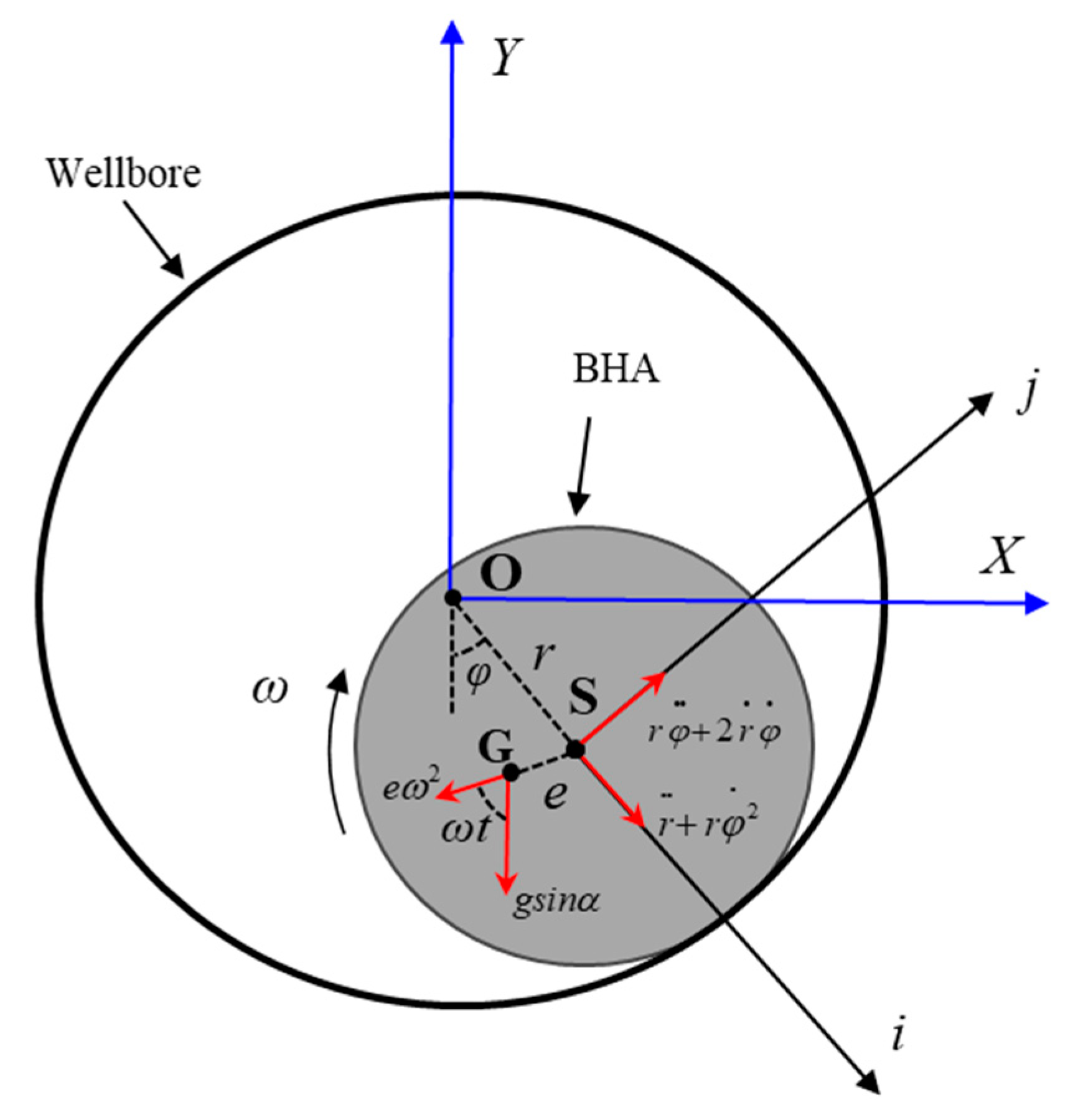
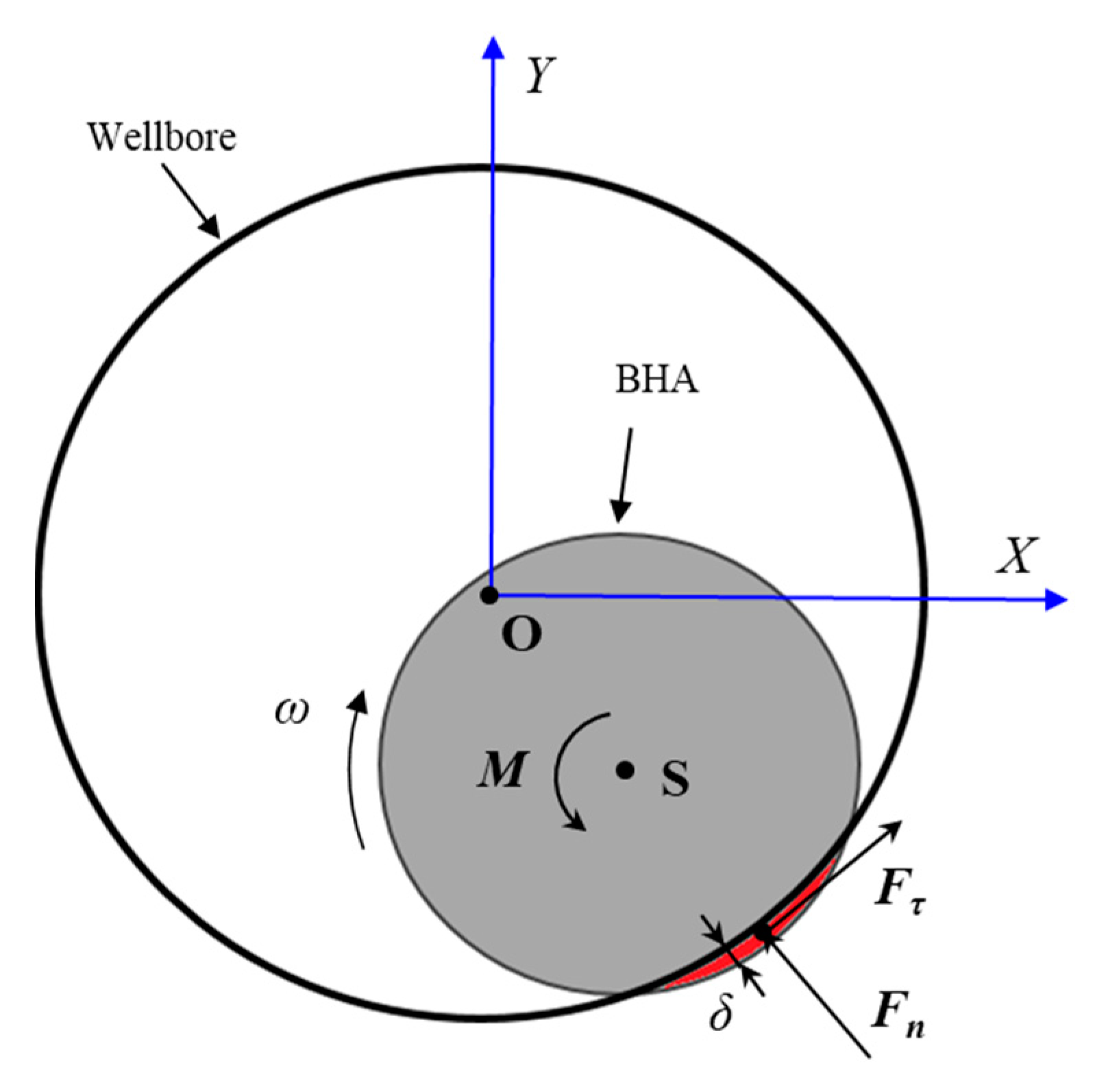



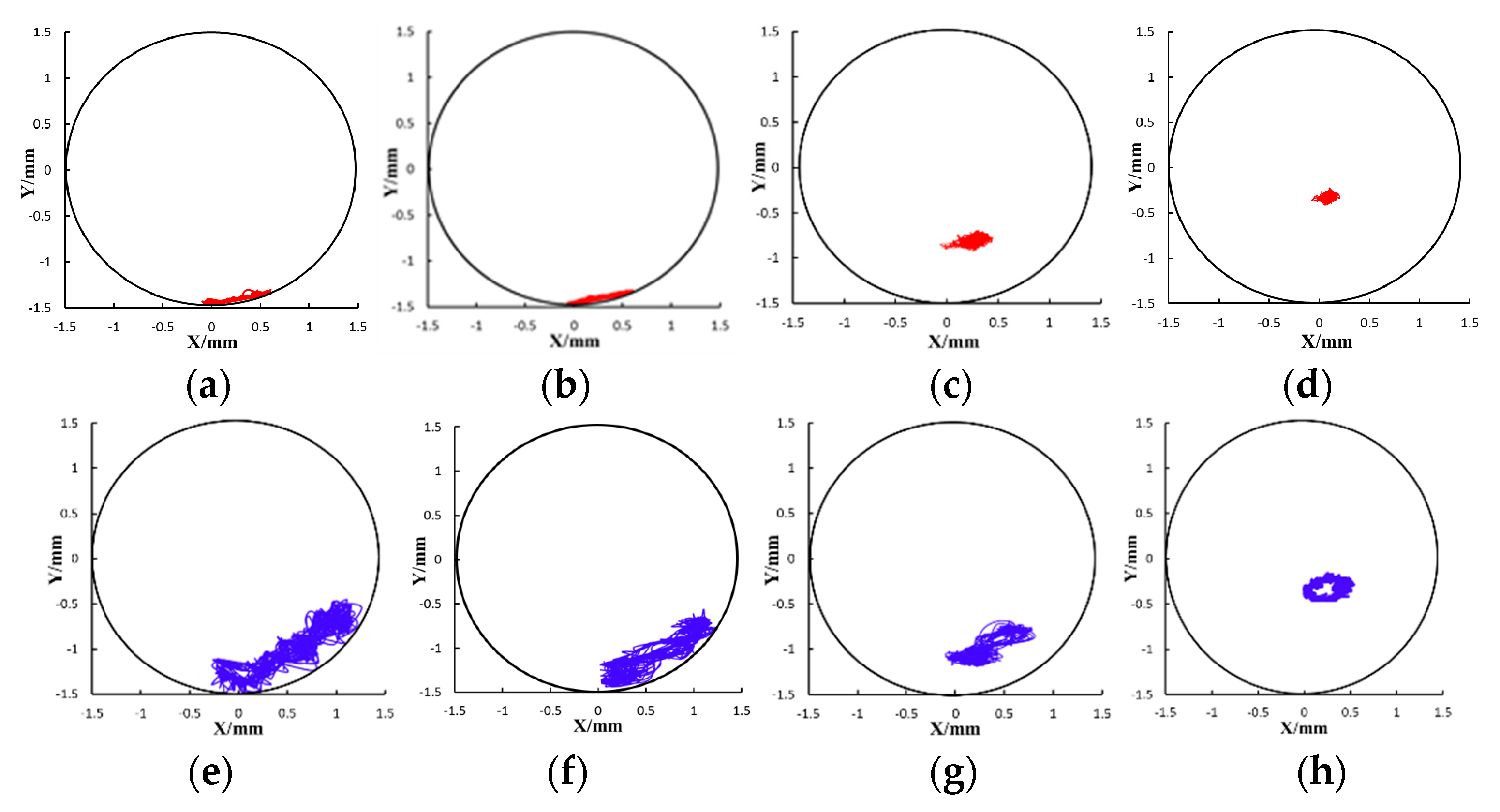
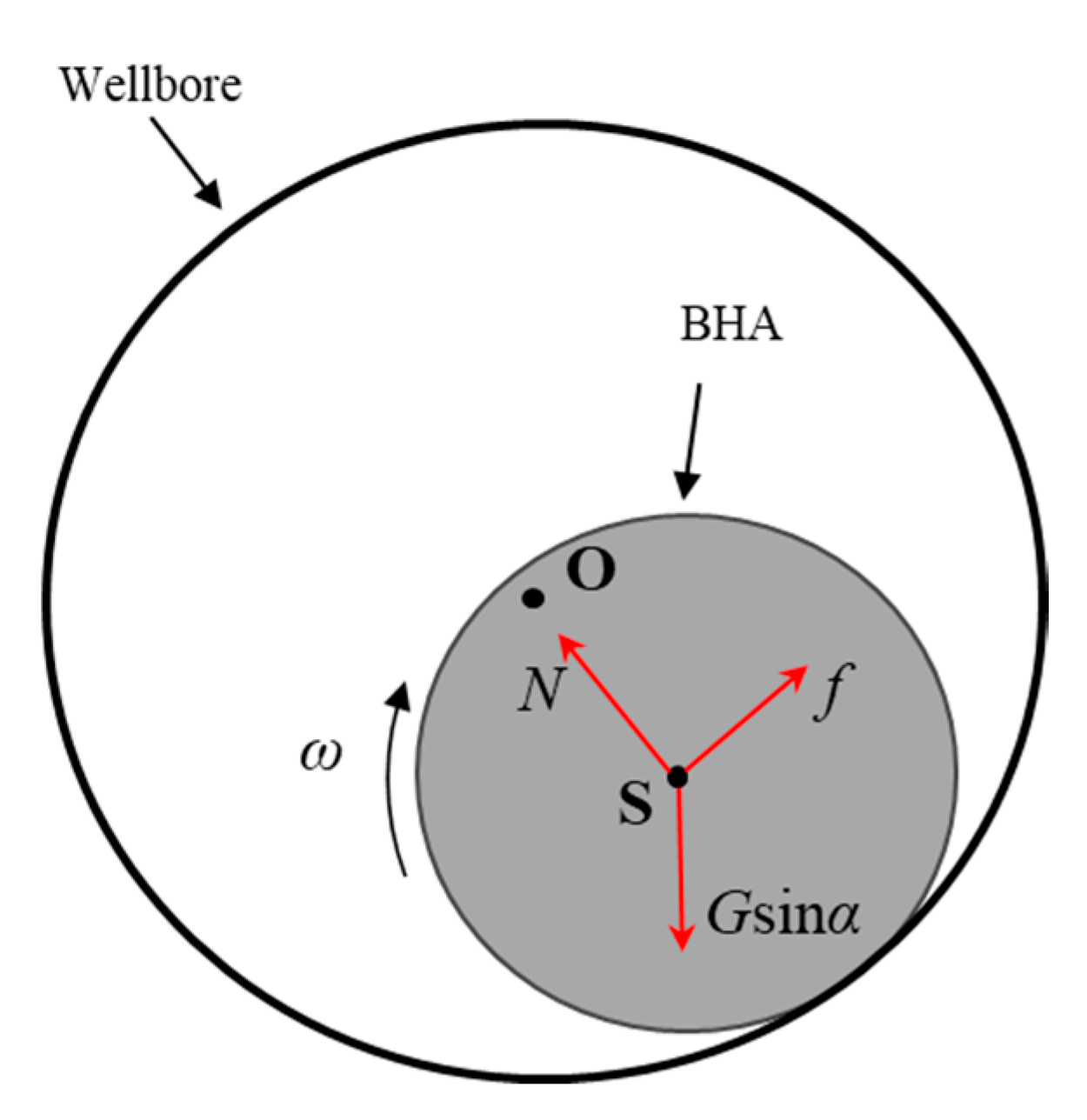
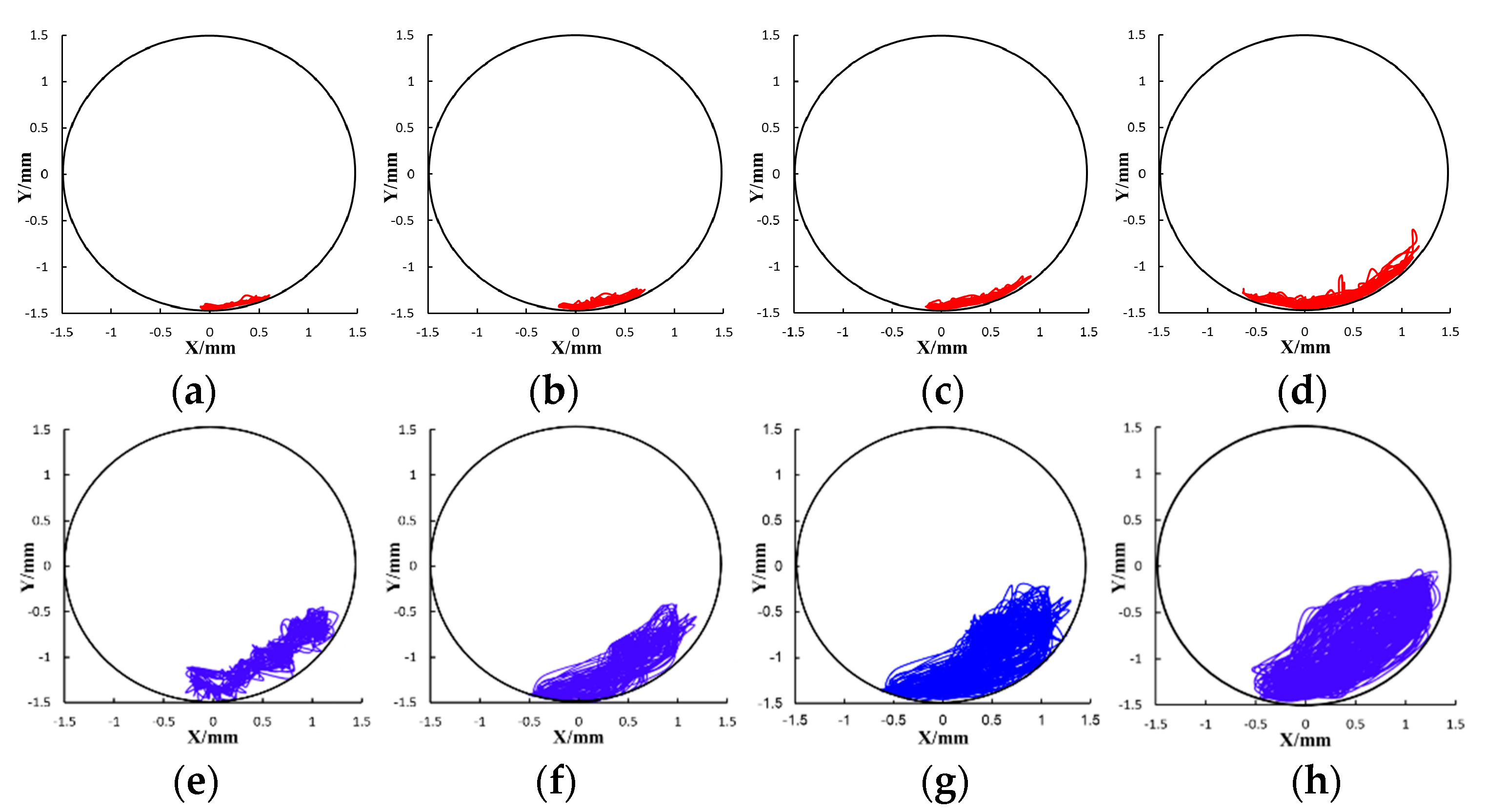
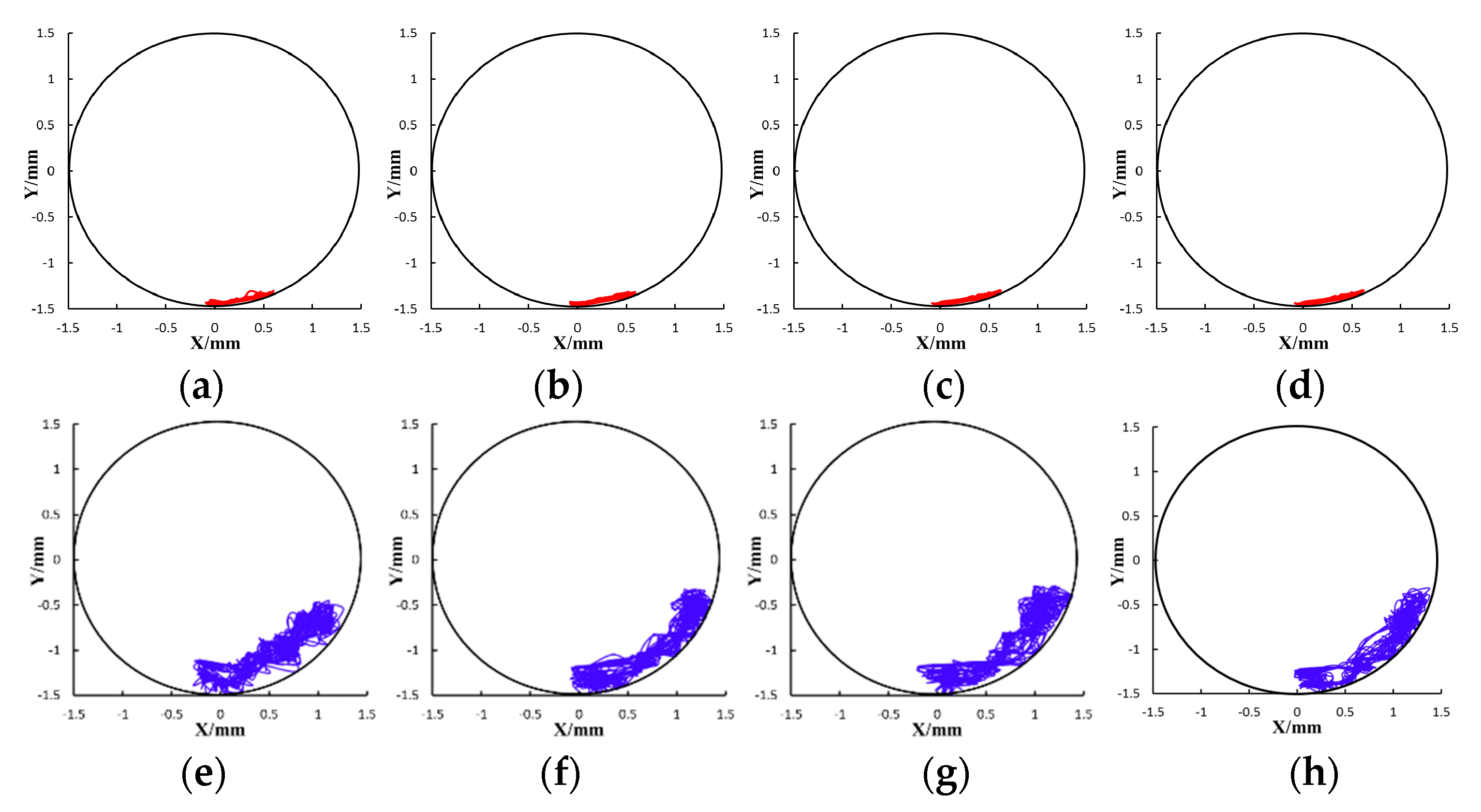

| Measuring Position | m1 | m2 | m3 | m4 |
|---|---|---|---|---|
| Numerical model (m) | 0.05 | 0.1 | 0.3 | 1.0 |
| Experimental model (m) | 0.05 | 0.1 | 0.3 | 1.0 |
| Engineering prototype (m) | 2.15 | 4.3 | 12.9 | 43.0 |
| Rotate Speed | ω1 | ω2 | ω3 | ω4 |
|---|---|---|---|---|
| Numerical model (r/min) | 100 | 300 | 500 | 700 |
| Experimental model (r/min) | 100 | 300 | 500 | 700 |
| Engineering prototype (r/min) | 25 | 75 | 125 | 175 |
| WOB | W1 | W2 | W3 | W4 |
|---|---|---|---|---|
| Numerical model (N) | 0 | 0.23 | 0.46 | 0.69 |
| Experimental model (N) | 0 | 0.23 | 0.46 | 0.69 |
| Engineering prototype (kN) | 0 | 30 | 60 | 90 |
| Friction Coefficient | μ1 | μ2 | μ3 | μ4 |
|---|---|---|---|---|
| Numerical model | 0.1 | 0.2 | 0.3 | 0.4 |
| Engineering prototype | 0.1 | 0.2 | 0.3 | 0.4 |
| Property | Value | Units |
|---|---|---|
| Length of collar | 2 | m |
| Outer diameter of collar | 5 | mm |
| Outer diameter of bit | 8 | mm |
| Inner diameter of wellbore | 8 | mm |
| Density of collar | 1200 | kg/m3 |
| Elasticity modulus of collar | 3 | GPa |
| Poisson ratio of collar | 0.47 | - |
| Measuring Position | X-Direction | Y-Direction |
|---|---|---|
| 1.0 m from the drill bit | 0.70 mm | 0.20 mm |
| 0.3 m from the drill bit | 0.49 mm | 0.17 mm |
| 0.1 m from the drill bit | 0.35 mm | 0.14 mm |
| 0.05 m from the drill bit | 0.13 mm | 0.10 mm |
| Measuring Position | X-Direction | Y-Direction |
|---|---|---|
| 1.0 m from the drill bit | 1.29 mm | 1.10 mm |
| 0.3 m from the drill bit | 1.13 mm | 0.87 mm |
| 0.1 m from the drill bit | 0.78 mm | 0.55 mm |
| 0.05 m from the drill bit | 0.48 mm | 0.32 mm |
| Rotate Speed | X-Direction | Y-Direction |
|---|---|---|
| 100 r/min | 0.70 mm | 0.20 mm |
| 300 r/min | 0.86 mm | 0.27 mm |
| 500 r/min | 1.12 mm | 0.50 mm |
| 700 r/min | 1.76 mm | 0.84 mm |
| Rotate Speed | X-Direction | Y-Direction |
|---|---|---|
| 100 r/min | 1.29 mm | 1.10 mm |
| 300 r/min | 1.35 mm | 1.21 mm |
| 500 r/min | 1.45 mm | 1.28 mm |
| 700 r/min | 1.70 mm | 1.35 mm |
| WOB | X-Direction | Y-Direction |
|---|---|---|
| 0 N | 0.70 mm | 0.20 mm |
| 0.23 N | 0.67 mm | 0.19 mm |
| 0.46 N | 0.70 mm | 0.20 mm |
| 0.69 N | 0.72 mm | 0.22 mm |
| WOB | X-Direction | Y-Direction |
|---|---|---|
| 0 N | 1.29 mm | 1.10 mm |
| 0.23 N | 1.31 mm | 1.13 mm |
| 0.46 N | 1.30 mm | 1.15 mm |
| 0.69 N | 1.29 mm | 1.11 mm |
| Friction Coefficient | X-Direction | Y-Direction |
|---|---|---|
| 0.1 | 0.15 mm | 0.12 mm |
| 0.2 | 0.86 mm | 0.27 mm |
| 0.3 | 0.89 mm | 0.38 mm |
| 0.4 | 1.08 mm | 0.48 mm |
© 2020 by the authors. Licensee MDPI, Basel, Switzerland. This article is an open access article distributed under the terms and conditions of the Creative Commons Attribution (CC BY) license (http://creativecommons.org/licenses/by/4.0/).
Share and Cite
Li, W.; Huang, G.; Ni, H.; Yu, F.; Jiang, W. Modeling and Experimental Study on Motion States of Laboratory-Scale Bottom Hole Assembly in Horizontal Wells. Energies 2020, 13, 925. https://doi.org/10.3390/en13040925
Li W, Huang G, Ni H, Yu F, Jiang W. Modeling and Experimental Study on Motion States of Laboratory-Scale Bottom Hole Assembly in Horizontal Wells. Energies. 2020; 13(4):925. https://doi.org/10.3390/en13040925
Chicago/Turabian StyleLi, Wei, Genlu Huang, Hongjian Ni, Fan Yu, and Wu Jiang. 2020. "Modeling and Experimental Study on Motion States of Laboratory-Scale Bottom Hole Assembly in Horizontal Wells" Energies 13, no. 4: 925. https://doi.org/10.3390/en13040925
APA StyleLi, W., Huang, G., Ni, H., Yu, F., & Jiang, W. (2020). Modeling and Experimental Study on Motion States of Laboratory-Scale Bottom Hole Assembly in Horizontal Wells. Energies, 13(4), 925. https://doi.org/10.3390/en13040925




